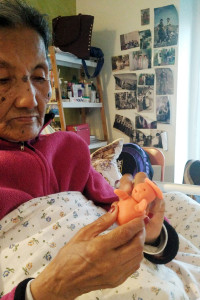Contact Us




Dementia is a challenging journey that impacts not only memory but also the overall well-being of individuals as they enter their later years. Facing difficulties in recalling memories and comprehending the world around them, those with a diagnosis of dementia often find themselves grappling with a complex puzzle. In this intricate puzzle of elderly care, a piece of the solution lies in the realm of sensory engagement.
As the natural process of aging unfolds, the sensory functions of elders deteriorate as they grow older. Sensory activities improve the emotional and physical health of people living with dementia. Sensory stimulation is the activation of one or more of the senses such as taste, smell, vision, hearing, and touch.
In recent times, Multi-Sensory Stimulation (MSS) has become a progressively popular approach to care and it is used in a large number of Dementia Care Centers such as Samvedna Care
The stimulation is done with the help of various tools and materials, which helps in stimulating the senses. For example, a walk on the beach: the sound of waves, a video showing the mountains, and some shells to touch. This helps in creating a virtual environment under different themes.
Sensory activities provides a level of stimulation that boosts awareness and attention due to the directness and simplicity of the task.
It is very useful for mood enhancement, cognition and relaxation.
This includes a vast range of sounds, ranging from natural sounds (a gentle rainfall) to generated sounds such as music like a Mozart symphony or an old song.
Tuning in to sounds is a critical part of connecting with our senses. Many dementia patients have hearing problems, and so it is essential to stimulate this sense, remembering that adjustments may be needed.
Consider:
 2. Tactile stimulation
2. Tactile stimulation This type of stimulation is concerned with awareness of texture and touch.
A study by the American Journal of Alzheimer’s Disease and other Dementia states that tactile stimulation improves the well-being of Dementia patients.
Consider:
• Create a virtual beach. Pour some sand in an empty box and fill it with shells and stones and a collection of balls.
• Brain paths are used and stimulated every time we use our hands to hold something. It provides stimulation for 3000 nerve receptors in each of our finger tips, and then these nerves send impulses to stimulate the brain.
• Other things like sandpaper, plastic fruits, and pine cones can also be used in tactile stimulation.
Vision is one of the most important senses which helps us gain an excessive amount of information.
Tragically, Alzheimer’s disease and different dementias can significantly affect the visual processing system.
Consider:
Some of our most grounded memories, our most strong affiliations, are activated by smell. A scent that you connect with an occasion or a moment from the past will transport one to that time.
The basic oils utilized as a part of aromatherapy like peppermint, lavender, and rosemary, are well-known, yet aromatherapy is considerably more than sensory stimulation. Distinctive healing properties are asserted for various oils.
The following are some essential oils that are known to have unique properties:
A favourite dinner or a specific dish one has not had for a long time triggers a surge of memories. There are a significant number of things in the kitchen that can be used to empower the taste buds.
A Snoezelen Room is a therapeutic environment created to provide stimulation for patients with dementia. A snoezelen room displays optical illusions with combined lighting effects, aromas, colors, textures and sounds to stimulate a person’s olfactory, auditory and gustatory systems.
Incorporating these multi-sensory experiences into daily care routines can have profound effects on dementia patients’ well-being after the diagnosis of dementia. One organization that has embraced this approach is Samvedna Care, where multiple sensory stimulation is used to enhance the lives of seniors facing cognitive challenges. Through these activities, individuals are offered a way to connect with their surroundings, spark memories, and experience joy despite the difficulties posed by dementia.
The beauty of multi-sensory stimulation lies in its ability to bypass the limitations of verbal communication. It’s a reminder that amidst the complexities of dementia, the power of human connection and engagement remains steadfast. As we continue to explore innovative approaches to care, multiple sensory stimulation stands as a beacon of hope, offering moments of clarity, joy, and meaningful interactions for those on the dementia journey.
Stimulating the senses of the person with dementia has many positive benefits like mood enhancement, increased socialization, improved cognition functioning and alertness. It is significant to draw on emotions and recollections by connecting with all five senses. You’ll never know the memories that will emerge through various processes and activities.
We at Samvedna Care aim to help seniors live happy, active, and independent lives, in the comfort of their home and community through interactive caregiving and elderly care services.
Our Dementia Care services are designed with a comprehensive approach to providing the best possible support for individuals and families dealing with dementia. We understand that every person’s journey with dementia is unique, and our services are tailored to meet their specific needs.
Assessment: We commence our care journey by thoroughly evaluating the individual’s condition, needs, and preferences, especially in the context of a diagnosis of dementia. This assessment serves as a crucial starting point, allowing us to gain a deeper understanding of their unique circumstances. This understanding becomes the cornerstone for crafting a personalized care plan that aligns perfectly with their requirements. This step is vital as it sets the groundwork for our holistic care approach, ensuring that every aspect of their well-being is considered and addressed.
Dementia Therapies: Our range of dementia therapies is designed to stimulate the mind, engage the senses, and improve overall well-being. These therapies are not only about slowing down cognitive decline but also about enhancing the individual’s quality of life. Through activities like memory games, sensory stimulation, and creative expression, we aim to keep the person engaged and connected.
Caregiver Enablement: We understand that caregivers play a pivotal role in the well-being of individuals with dementia. Our caregiver enablement programs provide education, training, and resources to family members and caregivers. We equip them with the skills and knowledge they need to provide the best care possible while also taking care of their own well-being.
Medical Consultation: Medical consultation is an integral part of our Dementia Care services. We work closely with medical professionals to ensure that the individual’s medical needs are addressed properly. This collaboration helps us provide holistic care that encompasses both physical and mental well-being.
At the heart of our Dementia Care services is the desire to enhance the lives of individuals living with dementia and their families. We believe that through a combination of personalized assessment, engaging therapies, caregiver support, and medical guidance, we can make a positive impact on the dementia journey. Our goal is to create an environment where individuals with dementia can thrive, maintain their dignity, and experience moments of joy and connection despite the challenges they face.